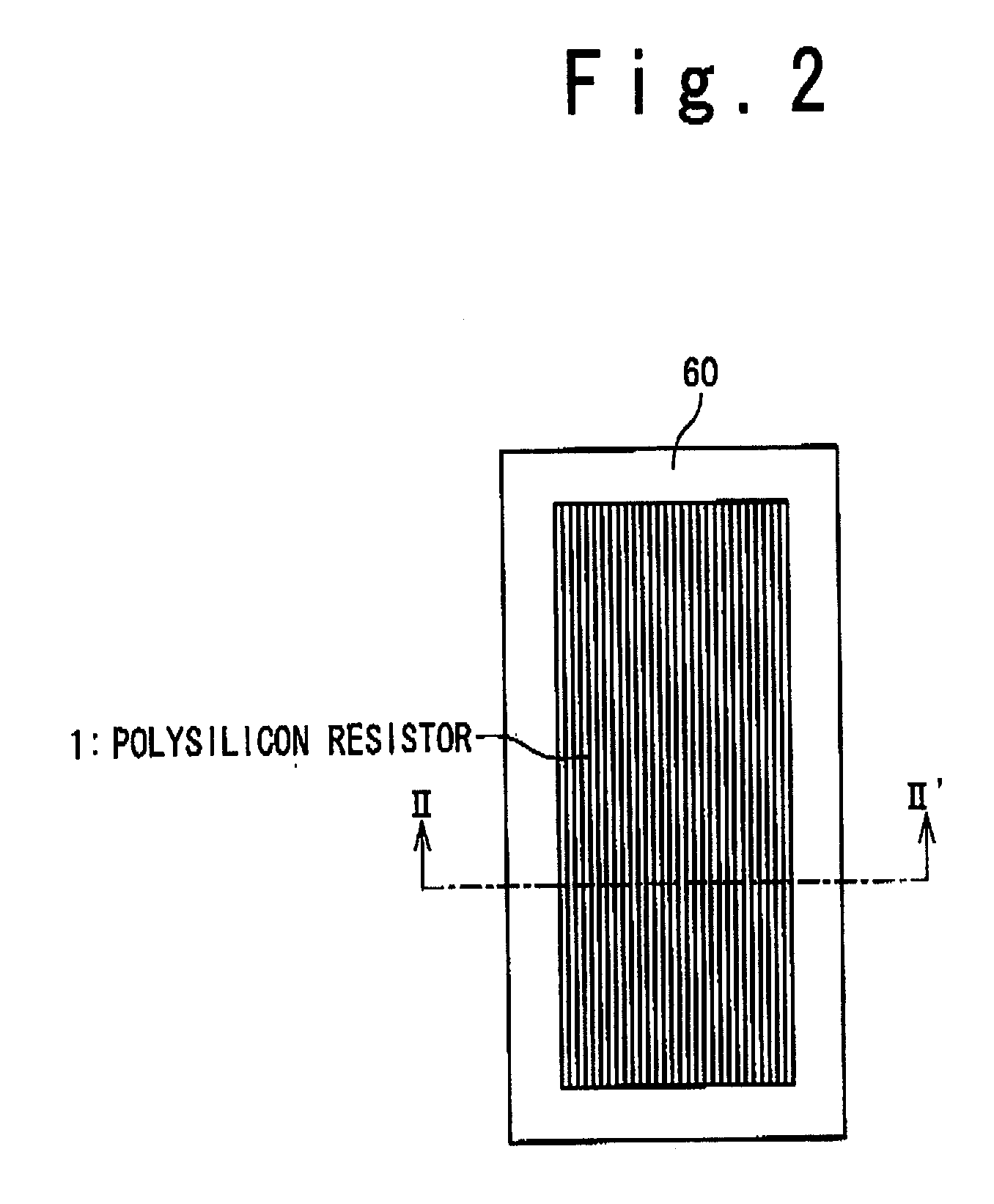Resistor element and manufacturing method thereof
a technology of resistor elements and manufacturing methods, which is applied in the direction of semiconductor devices, semiconductor/solid-state device details, electrical devices, etc., can solve the problems of difficult control of thickness and the area failure of gradation display, and difficulty in forming a uniform thickness of the silicide layer, so as to improve the product liability
- Summary
- Abstract
- Description
- Claims
- Application Information
AI Technical Summary
Benefits of technology
Problems solved by technology
Method used
Image
Examples
first embodiment
1. First Embodiment
1-1. Structure
[0025]FIG. 2 is a plan view illustrating the structure of the resistor element of the first embodiment. The resistor element according to the present embodiment is provided with a polysilicon resistor 1 which has a predetermined area within a plane. The polysilicon resistor 1 is surrounded by a sidewall 60 in the plane. The sectional view along the line II-II′ in the figure is shown in FIG. 3.
[0026] As shown in FIG. 3, an element separation structure 20 is formed into a substrate 10. The substrate 10 is a P-type silicon substrate, for example. The element separation structure 20 is STI (Shallow Trench Isolation) structure or LOCOS (LOCal Oxidation of Silicon) structure. Furthermore, the structure corresponding to the polysilicon resistor 1 is formed in a predetermined position on the substrate 10. Specifically, a polysilicon layer 31 is formed on the substrate 10 (element separation structure 20), a lower barrier layer 41 is formed on the polysili...
second embodiment
2. Second Embodiment
[0051] In a second embodiment of the present invention, the structure where the upper barrier layer 42 is eliminated from the resistor element according to the above mentioned first embodiment is described. Referring to FIGS. 5A-5D, the manufacturing process of the resistor element according to the present embodiment is described. The explanations which already have described in the first embodiment are suitably omitted for avoiding redundant description.
[0052] After the process shown in FIGS. 4A-4F is completed, the metal layer 70 for the silicidation is formed on the surface of the upper polysilicon layer 32. As a result, a structure shown in FIG. 5A is obtained. The metal layer 70 is a Ti film with the thickness of 200 A, for example. This metal layer 70 is formed so that the upper surface S70 will be lower than the topmost part Z of the sidewall 60.
[0053] Subsequently, a heat treatment is performed and the silicidation occurs between the upper polysilicon l...
third embodiment
3. Third Embodiment
[0058] In a third embodiment of the present invention, the structure where the lower barrier layer 41 is eliminated from the resistance element according to the above-mentioned first embodiment is provided. Referring to FIGS. 6A-6E, the manufacturing process of the resistance element according to the present embodiment is explained. The explanations which already have described in the first embodiment are suitably omitted for avoiding redundant description.
[0059] First, as shown in FIG. 6A, the polysilicon structure including a polysilicon layer 30 with the thickness of about 1500 A is formed on the substrate 10 (element separation structure 20). The sidewall 60 is formed in on both sides of the polysilicon structure. The sidewall 60 is formed for surrounding all the sides of the polysilicon layer 30.
[0060] Subsequently, the polysilicon layer 30 is selectively etched about 500 A.
[0061] This is realizable by the selectivity etching or the etching employing the p...
PUM
| Property | Measurement | Unit |
|---|---|---|
| resistivity | aaaaa | aaaaa |
| depth | aaaaa | aaaaa |
| resistance | aaaaa | aaaaa |
Abstract
Description
Claims
Application Information
 Login to View More
Login to View More - R&D
- Intellectual Property
- Life Sciences
- Materials
- Tech Scout
- Unparalleled Data Quality
- Higher Quality Content
- 60% Fewer Hallucinations
Browse by: Latest US Patents, China's latest patents, Technical Efficacy Thesaurus, Application Domain, Technology Topic, Popular Technical Reports.
© 2025 PatSnap. All rights reserved.Legal|Privacy policy|Modern Slavery Act Transparency Statement|Sitemap|About US| Contact US: help@patsnap.com



